Marion Brooks Natural Area, Elk County, PA
Marion Brooks
NA is the kind of place where when you pull into the parking
lot, you say “Wow!”
In front of you as far as you can see are bouquet-like sprays of
white paper birch trees rising above the snow covered forest
floor. At first
glance the paper birch trees are all that you see.
Each multitrunk cluster is made up of three or more
individual stems 8 to 12 inches in diameter and 40 to 70 feet
tall. As you gaze
upon the scene you see scatter examples of other tree species
among this virtual monoculture of white.
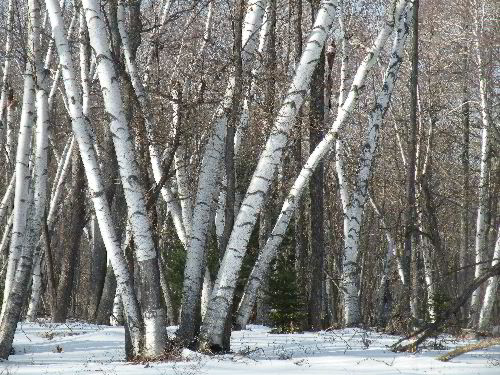 Marion
Brooks entrance area Marion
Brooks entrance area
I had not really known what to
expect when I decided to visit this site on a bright, cold New
Years morning. I
typically read what materials I can find in my library and on
the internet prior to visiting a site to get a feel of what to
expect, and what to look for while visiting.
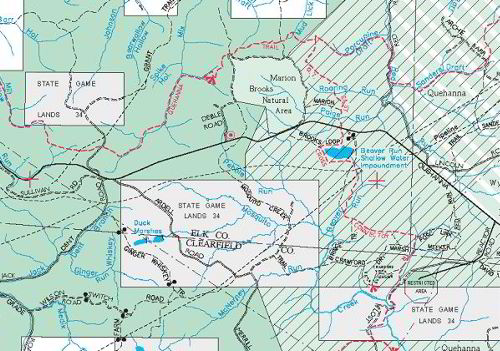
The reports talked of a unique
stand of paper birch trees dominating this 975 acre tract with
little else present.
I had seen some photos, but the reality was much better
than this preamble.
This natural area is small portion of the Quehanna Wild Area
primarily located in Elk, Clearfield, and Cameron Counties in
north central PA.
It is also park of the range of the elk herd here in
Pennsylvania.
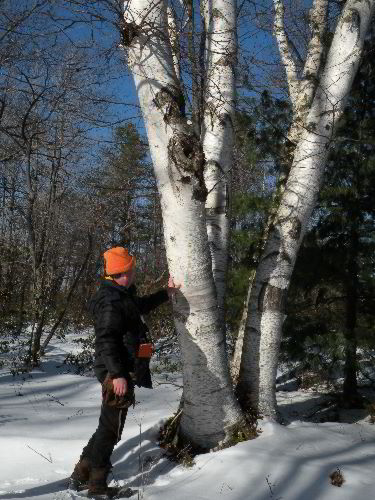 Paper Birch
Paper Birch
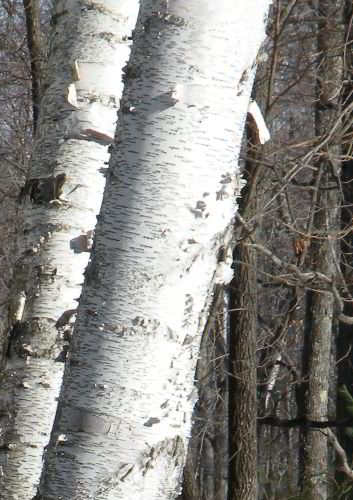 Paper Birch
Paper Birch
This entire area is part of the
Allegheny Plateau region on PA.
In the late 1800’s the area was extensively logged.
First for white pines, then later with the use of logging
railroads, virtually everything else.
This site is located on a small stream called Paige Run.
It is too small for floating logs as was common on the
larger streams in the area.
Instead when first logged only the most valuable timber,
the white pine was removed.
These logs were drug and rolled to holding dams built in
the small stream valleys like Paige Run.
In the spring with the melting snow and runoff, these
splash dams were breached and in a swoosh of water the logs
would be carried down to the larger streams to be floated to
collection and sorting areas on the Susquehanna River at Lock
Have and Williamsport.
When the white pines were gone logging railroads were
built to harvest the rest.
By around 1912, the entire area was a wasteland of barren
and eroding hills.
Repeated fires took place among the branches and tree tops left
behind the brush that followed the logging operation. These
frequent and intense fires burned across the area and devoured
even the organic materials in the soil, leaving behind a mineral
soil with virtually no organic content.
It was in this soil that a few pioneering species, like
paper birch were able to establish a foothold, where nothing
else would grow.
The monoculture of paper birch is the result of these events
almost 100 years ago.
Even now in large areas of the tract nothing else has
grown. A good
account of the history of the area can be found in the book:
“Great Buffalo
Swamp, A Trail Guide and Historical Record for the Quehanna
Plateau and Moshannon State Forest”
by Ralph Seely.
|
Marion Brooks Natural
Area, Elk County, PA |
|
|
|
|
number |
species |
scientific |
girth |
height |
Date |
Measured By |
Method |
|
1 |
Northern Red Oak |
Quercus rubra |
7' 11" |
80.15 |
1-Jan-09 |
Edward Frank |
ENTS |
|
2 |
American Beech |
Fagus grandifolia |
2' 11" |
57.03 |
1-Jan-09 |
Edward Frank |
ENTS |
|
3 |
Red Maple |
Acer rubrum |
5' 1" |
70.08 |
1-Jan-09 |
Edward Frank |
ENTS |
|
4 |
Black Cherry |
Prunus serotina |
5' 3" |
81 |
1-Jan-09 |
Edward Frank |
ENTS |
|
5 |
Paper Birch |
Betula papyifera |
3' 11" |
62.97 |
1-Jan-09 |
Edward Frank |
ENTS |
|
6 |
Sassafras |
Sassafras albidum |
3' 11" |
58.56 |
1-Jan-09 |
Edward Frank |
ENTS |
|
7 |
Red Maple |
Acer rubrum |
6' 6" |
85.03 |
1-Jan-09 |
Edward Frank |
ENTS |
|
8 |
White Pine |
Pinus strobus |
3' 9" |
35.08 |
1-Jan-09 |
Edward Frank |
ENTS |
|
9 |
Paper Birch |
Betula papyifera |
3' 10" |
74.83 |
1-Jan-09 |
Edward Frank |
ENTS |
|
10 |
Pitch Pine |
Pinus rigida |
2' 9" |
36.43 |
1-Jan-09 |
Edward Frank |
ENTS |
|
11 |
Norway Spruce |
Picea abies |
4.2" |
9 |
1-Jan-09 |
Edward Frank |
ENTS |
|
12 |
Pitch Pine |
Pinus rigida |
5'
4.5" |
64.09 |
1-Jan-09 |
Edward Frank |
ENTS |
|
13 |
Larch, European |
Laris decidua |
4' 8" |
72.17 |
1-Jan-09 |
Edward Frank |
ENTS |
|
14 |
Norway Spruce |
Picea abies |
5'
5.5" |
77.26 |
1-Jan-09 |
Edward Frank |
ENTS |
|
15 |
White Oak |
Quercus alba |
6' 0" |
61.16 |
1-Jan-09 |
Edward Frank |
ENTS |
|
16 |
Pitch Pine |
Pinus rigida |
~5' |
67.77 |
1-Jan-09 |
Edward Frank |
ENTS |
|
17 |
Pitch Pine |
Pinus rigida |
5' 9" |
60.83 |
1-Jan-09 |
Edward Frank |
ENTS |
|
18 |
White Pine |
Pinus strobus |
~ |
84.36 |
1-Jan-09 |
Edward Frank |
ENTS |
|
19 |
Eastern hemlock |
Tsuga canadiensis |
4' 6" |
59.81 |
1-Jan-09 |
Edward Frank |
ENTS |
|
20 |
White Pine |
Pinus strobus |
11' 2" triple |
102.38 |
1-Jan-09 |
Edward Frank |
ENTS |
|
21 |
Pitch Pine |
Pinus rigida |
6' 2" |
63.67 |
1-Jan-09 |
Edward Frank |
ENTS |
|
22 |
Paper Birch |
Betula papyifera |
3' 11" |
45 |
1-Jan-09 |
Edward Frank |
ENTS |
I did not explore the entire area on the trip this afternoon.
Much of my time was spent in the 20-30 acre stand near the
parking area. This was the best and purest of the paper birch
stands I found on the trip. Here there were very few other
species of trees and they were scattered infrequently among the
birches. Beyond this area the paper birches continued to appear
and add a brilliant splash of white to the forest trees, but
their frequency declined from perhaps 95% of the trees present
to perhaps 20%. I of course do not know what is found in areas
did not visit. In areas outside the entrance patch the trees
also tended to be bigger in size. For an unusual situation like
this, with an area of stunted and almost monoculture forest, and
a more diverse forest elsewhere. I think a good approach would
be to develop a Rucker Index and profile for just the areas of
the nearly pure paper birch stand and a separate Rucker Index
and profile for the site as a whole.
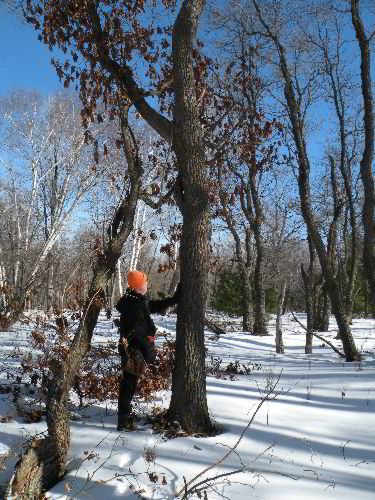
Sassafras
The results of my days measurements are presented above. The
upper portion of the list in light blue color, representing 11
measurements were taken within the paper birch stand. The lower
values, 12 through 22, were measurements I took in other areas
of the park. I unfortunately did not find enough species within
the birch stand to complete a ten species Rucker Index. There
were more species present, but was unsure of my
species identifications.
Paper Birch Stand: RI5 = 75.91
Marion Brooks RI5 = 82.03
Marion Brooks RI10 = 72.77
Still a Rucker Index seems to be inadequate to describe the
character of the site. I will need to find a better way to
characterize it on a return trip. Within the paper birch area
the most common secondary species was sassafras, and then red
oak. Other species were less frequent. White pines were
present as small trees generally less than 15 feet tall.
Scattered about also were Norway Spruce seedlings and saplings.
the largest of these were 9 feet tall. other species present
included witch hazel and some whose identification I was
unsure.
There is a section on Marion Brooks natural Area within the Elk
County Natural Heritage Inventory by the Western Pennsylvania
Conservancy, 2006.
This site, located within the
Marion Brooks Natural Area, contains a small depression
wetland supporting a population of
creeping snowberry
(Gaultheria hispidula),
a plant species of special concern. Hemlock stumps, decaying
remnants of logging from the early part of the twentieth
century, contribute to the pit and mound microtopography
that characterizes the wetland. Creeping snowberry occurs in
the portion of the wetland where scattered white pine (Pinus
strobus), red maple (Acer rubrum), hemlock (Tsuga
canadensis), and pitch pine (Pinus rigida) form a
sparse canopy. It can be found growing on the slightly
elevated mounds, along with low sweet blueberry (Vaccinium
angustifolium), huckleberry (Gaylussacia baccata),
swamp dewberry (Rubus hispidus), and cinnamon fern (Osmunda
cinnamomea). Several species of sedge (Carex
folliculata, C. gynandra, C. rosea), bunchberry (Cornus
canadensis), and round-leaved sundew (Drosera
rotundifolia) also grow throughout the wetland. A thick
carpet of sphagnum moss helps maintain the acidic character
of the wetland. Adjacent to the wetland is an
aspen/gray (paper) birch forest, an early successional
forest community considered rare in Pennsylvania. Following
repeated wildfires that resulted from logging during the
early part of the last century, a dense, nearly pure stand
of paper birch (Betula papyifera) grew up. The fires
burned away much of the soil-forming organic matter on the
forest floor, leaving thin, nutrient-poor soil unsuitable
for anything but the pioneering birch (Fergus 2002). Other
trees intermingled with the birch include sassafras (Sassafras
albidum), red maple, black cherry (Prunus serotina),
serviceberry (Amelanchier sp.), and witch-hazel (Hamamelis
virginiana). Bracken fern (Pteridium aquilinium)
dominates the herb layer. The supporting landscape
extends to the boundary of the immediate watershed
hydrologically linked to the depression wetland.
I did not locate and of
the serviceberry, likely because I could not identify it if
found it. After leaving the entrance area a followed Losey Road
about 1/4 mile to Page Run and a short distance upstream of the
run on the northern side of the run. There were several
relatively large European larch trees near the culvert where the
road crossed the run. just past this culvert were a small
patch of Norway Spruce. These are likely the seed source
for the Norway Spruce seedling and saplings within the paper
birch area. Exploring in this area I started to find some
larger pitch pines, white pines, and even a hemlock. There
is a loop trail leading off from here that extends a distance of
three miles or so. I left that trail for another day.
The tallest tree found in the day was a triple trunk White Pine
that just topped 102 feet.
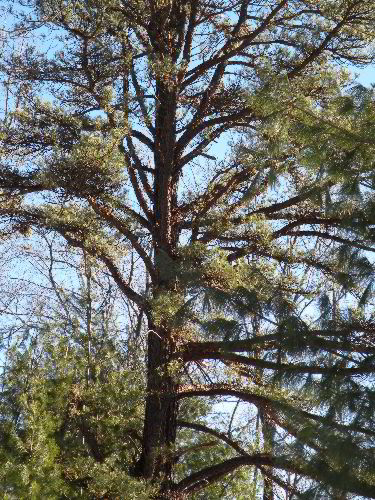 Pitch Pine
Pitch Pine
What really was
interesting in this area were the pitch pines. they are a
very and some tree, that looks old and gnarled even when young.
many of them were in the 5 foot girth and 60 + foot tall range.
This area also had a fair amount of mountain laurel, this
was a species absent from within the pure paper birch stand.
I am wondering how much alleopathy as affected the species
composition within the birch stand. If it has affected the
composition as much as the poor soils. Many of the
articles describe the paper birches as reaching senescence, but
I am not sure that is true.
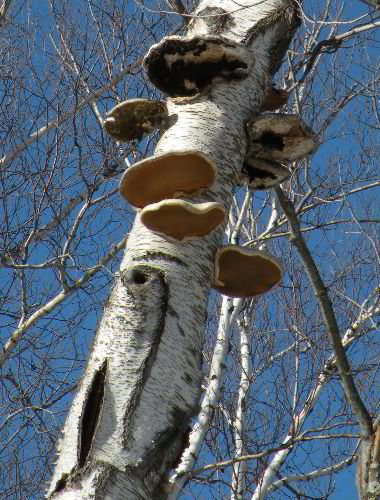
There are dead paper
birches, but even the largest appear to be healthy. a more
disturbing situation is the lack of saplings of paper birch, or
much of anything else within the birch stand. This is
likely the result of over browsing by deer. I would like
to see some deer exclusion fences placed in portions of the area
to see what plants and trees would be able to grow within the
enclosurers. There are some saplings of other species outside
the pure stand area, but even these are few in number.
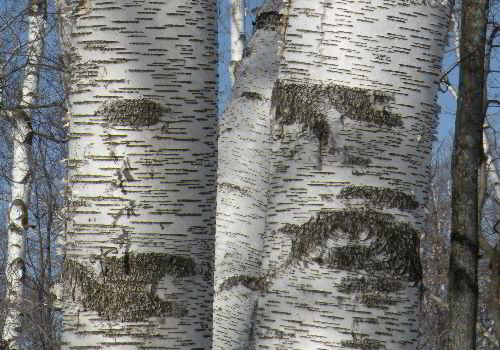
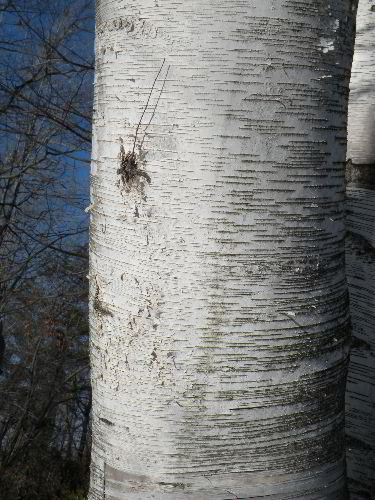
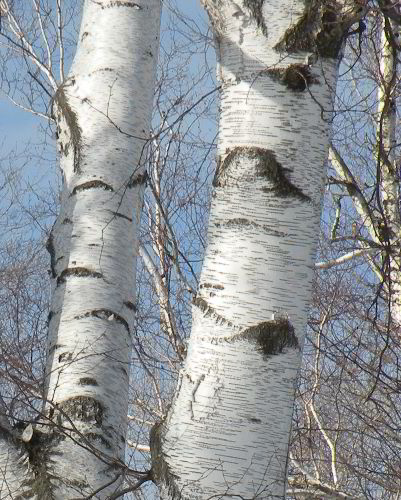
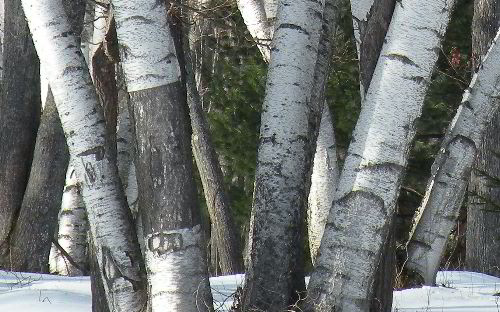
Some reports suggested
that gray birch was also present in the area, but I failed to
find any. Gray birch also has white bark, but is marked by
black patches or medallions at the base of limbs. these
are not present in paper birch. paper birch also exhibits
fine horizontal lines and paper-like peelings on the white bark.
I hope to make several more trips to the area and better
document what trees and patterns are present.
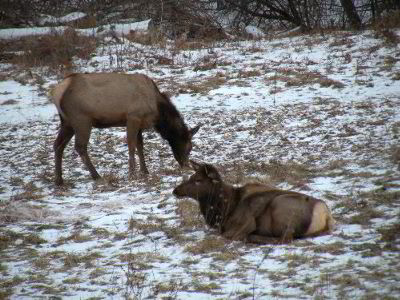
On the way to Marion
Brooks I passed a yard in the village of Caledonia in which
perhaps a dozen plus elk were grazing. Unfortunately
was in traffic ad there was no place to pull over ad take a
photo. As luck would have it, on the way back the elk herd
had moved to a different section of town, I was able to
pull off the road at a parking lot to a business that was closed
and grab a few shots of the elk.
Ed Frank
Continued at:
http://groups.google.com/group/entstrees/browse_thread/thread/504a17df1e2327b6?hl=en
|